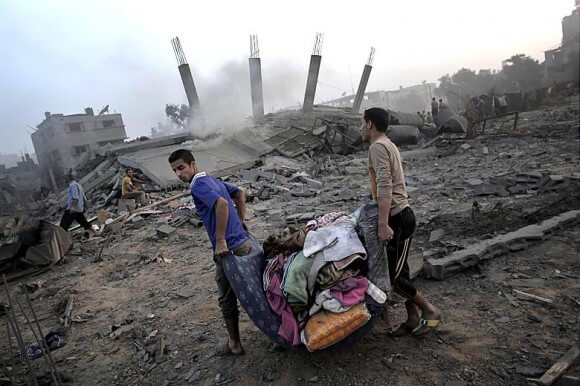
At least 35 Palestinians have been killed and over 300 wounded in Israeli airstrikes on the Gaza Strip in the first two nights of “Operation Protective Edge.” As Israel calls up thousands of army reservists for a potential ground assault, the deaths will likely increase even as their human cost is buried by misleading news and government reports.
News about Gaza can be confusing because it is hard to ascertain clear facts about a faraway place where reporters often are limited from entering or moving freely. It is further complicated by the failure of media and various governments to apply international law correctly, and to instead accept definitions from the players themselves about the legitimacy of their military goals and actions. Understanding what is happening in Gaza, and who is dying, is important because it happens with American aid, weapons, and complicity. Understanding principles of international law is critical if we want a world that abides by rule of law.
Principle #1: Israel cannot “defend itself” by any means.
There are laws of war, and they apply to all states. Known collectively as international humanitarian law (IHL), they are made of a number of international conventions, including the universally-accepted Geneva Conventions and their Additional Protocols, and widely-accepted principles known as “customary international law.” The main purpose of IHL is to minimize the effects of war.
IHL applies to Israel and to Hamas’s military wing or independent Palestinian militias. I’m not focusing on the Gazan militias because, despite their sincere intentions to commit war crimes, the damage they have wrought pales in comparison to Israel’s violations. In the past 11 years, rocket fire from Gaza has claimed 17 Israeli lives; in the past two days, Israeli attacks in Gaza have killed 35 Palestinians.
Principle #2: There is no legal meaning to the term “militant.”
“Militant” is used as often to describe fighters as it is to describe vegans and feminists; it has no meaning in IHL. There are only two types of people in IHL: civilians and combatants. A person’s status isn’t static: a civilian who takes up arms becomes a combatant, much like an off-duty army reservist is a civilian. For example, a woman who served in the Israeli army (as all Israelis are required to do) but is now escorting her children to school is a civilian. Membership in a political party such as Hamas, or the holding of violent beliefs (as both extremist Palestinians and Israelis do) doesn’t make someone a combatant.
In the first 5 days of the brutal 22-day Operation Cast Lead in 2008-2009, 3 of the 4 Israelis who had been killed were classed as “civilians” in media sources; this was a proper classification even though it is likely that all three have served in the Israeli army. In contrast, the reports on the Palestinian dead during the same period described only the women and children killed (9 women and 37 children) as civilians, letting readers assume that the rest of the dead were somehow engaged in combat. While an accurate count of the dead is frequently hard to obtain in Gaza due to the continued assaults (the Palestine Red Crescent Society (www.palestinercs.org) , Palestine Center for Human Rights-Gaza (www.pchrgaza.org), and B’Tselem (www.btselem.org) normally endeavor to keep count), from the targets and timing of many of the airstrikes it appears that most of the people killed were not combatants. ).
Principle #3: Attacking civilians is prohibited.
Since “militant” lacks meaning, people are either civilians or combatants. The most important principle of IHL is the prohibition on attacking civilians and civilian objects. Only military objectives may be targeted.
A military objective is “limited to those objects which . . . make an effective contribution to military action and whose total or partial destruction, capture or neutralization, in the circumstances ruling at the time, offers a definite military advantage” according to Geneva Convention Additional Protocol I 52(2). Absent evidence that a standard civilian objective has been converted to military use, it must be presumed to be a civilian objective.
During Operation Cast Lead, Israel targeted numerous civilian objectives including homes, mosques, a fitness center, a university, a pharmacy, government buildings, and civilian police stations; already during Operation Defensive Edge, homes and a poultry farm have been among the targets. Despite Israel’s claims to the contrary, everything Hamas-related isn’t a legitimate target; while Hamas has a military wing, it is also responsible for all civic functions in the Gaza Strip. (To illustrate: Hamas may attack an Israeli military base but can’t legitimately attack the Ministry of Education.)
Principle #4: Even if the target is a military objective, Israel must weigh the expected civilian damage.
Parties shouldn’t launch “an attack which may be expected to cause incidental loss of civilian life, injury to civilians, damage to civilian objects, or a combination thereof, which would be excessive in relation to the concrete and direct military advantage anticipated,” according to Additional Protocol I (52)(5)(B) (emphasis mine).
Israel maintains it doesn’t target civilians but incidentally kills them because of their proximity to military targets. Gaza, with a population of 1.5 million in an area of 140 square miles, is one of the most densely populated places on the planet. This poses special considerations for any military attack.
As I write this, the loss of civilian life continues. The silence from the U.S. government has been deafening; we must demand that our country engage in a way that upholds IHL, or we risk encouraging further killing of civilians and breakdown of legal order.
People interested in learning more about IHL should visit the International Committee of the Red Cross’s helpful IHL explanation on their website (www.icrc.org), and B’Tselem’s website for information on IHL and Israel (www.btselem.org).


Further:
Geneva Convention IV
Article 28 of the 1949 Geneva Convention IV provides: “The presence of a protected person may not be used to render certain points or areas immune from military operations.”
Sorry but this article read to me: “Israel can bomb BUT..”.
BTW. Rockets and mortars from Gaza do not become war crimes only when they kill or main. They are war crimes when they launch.
Even when they are launched by Al Aqsa Martyrs Brigades, controlled by President Mahmoud Abbas.
slightly off topic, but has anyone read the Times’ front page article today on the Gaza situation? all of the NYTimes “picks” for comments are pro-Israel/Zionist, although those are not representative
actually, sadly, reading more of the comments shows that the ones defending Israel and blaming everything on the Palestinians ARE representative. I’m surprised as recently I’ve felt the NY Times comments section shows more criticism of Israel. Maybe hasbara central is sending in more reinforcements to mitigate the current PR disaster